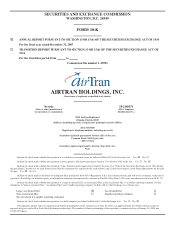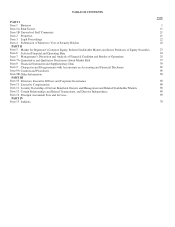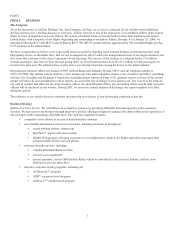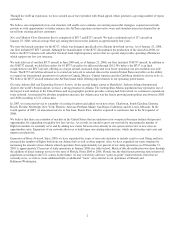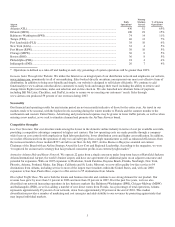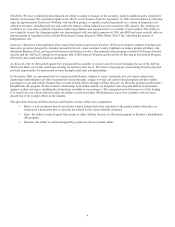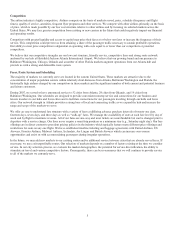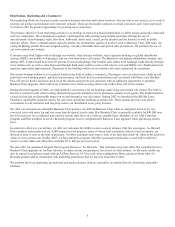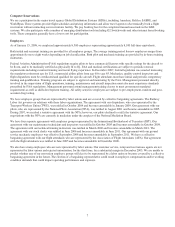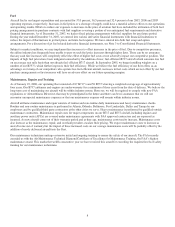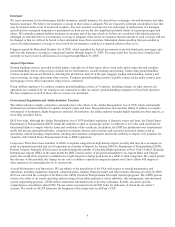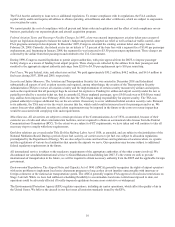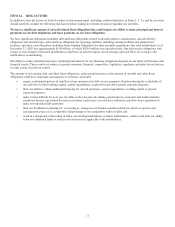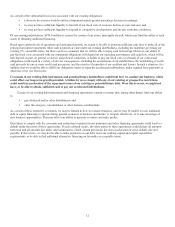Airtran 2007 Annual Report Download - page 8
Download and view the complete annual report
Please find page 8 of the 2007 Airtran annual report below. You can navigate through the pages in the report by either clicking on the pages listed below, or by using the keyword search tool below to find specific information within the annual report.
2
Through the AirTran experience, we have created an air travel product with broad appeal which generates a growing number of repeat
customers.
We believe our comparatively low-cost structure will enable us to continue our existing successful strategies, expand our network,
provide us with opportunities to further enhance the AirTran experience in innovative ways and stimulate increased demand for air
travel from existing and new customers.
New and Modern Fleet. Our entire fleet is comprised of B717 and B737 aircraft. We had a combined total of 137 aircraft on
January 23, 2008, with an average fleet age among the lowest in the industry at approximately four years.
We were the launch customer for the B717, which was designed specifically for efficient short-haul service. As of January 23, 2008,
our fleet included 87 B717 aircraft. Although the manufacturer of the B717 discontinued the production of the aircraft in 2006, we
believe the B717 remains well suited for the short-haul, high-frequency service that we operate and provides operating efficiencies
which support our low cost structure.
We took delivery of our first B737 aircraft in June 2004 and, as of January 23, 2008, our fleet included 50 B737 aircraft. In addition to
the 50 B737 aircraft, we hold firm orders for 63 B737 aircraft to be delivered through 2012. We believe the B737 is an ideal
complement to our B717 aircraft, offering us a larger aircraft, increased range and even lower operating cost per available seat mile
flown. The B737 aircraft has allowed us to extend our network to selected cities in the western United States and offers us the ability
to expand our international operations to locations in Canada, Mexico, Central America and the Caribbean should we choose to do so.
We believe the B737 aircraft enhances the AirTran brand while offering improvements in our operating performance.
Growing Atlanta Hub and Expanding Network System. As the second largest carrier at Hartsfield –Jackson Atlanta International
Airport, the world’s busiest airport, we have a strong presence in Atlanta. The metropolitan Atlanta population base represents one of
the largest travel markets in the United States and its geographic position provides a strong hub from which we continue to expand our
route network. As measured by absolute population increase, the Atlanta area was the fastest growing metropolitan area between 2000
and 2006 according to U.S. census data.
In 2007, we increased service to a number of existing locations and added seven new cities: Charleston, South Carolina; Daytona
Beach, Florida; Newburgh, New York; Phoenix, Arizona; Portland, Maine; San Diego, California; and St. Louis, Missouri. In the
fourth quarter of 2007, we announced service to San Juan, Puerto Rico, which is expected to commence late in the first quarter of
2008.
We believe that there are a number of markets in the United States that are underserved or overpriced by major airlines that present
opportunities for expanding our quality low fare service. As a result, we intend to grow our network by increasing the number of
flights in markets we currently serve and by adding new routes between cities already in our system and service to new cities as
opportunities arise. Expansion of our network allows us to build upon our existing infrastructure, which should reduce unit costs and
improve productivity.
Expansion of Route Network. Since 2000, we have expanded the scope of our route structure to include coast to coast flying and have
increased the number of flights both from our Atlanta hub as well as other airports. Also, we have expanded our route structure by
increasing the amount of non-Atlanta related operations from approximately ten percent of our daily operations as of December 31,
2001 to approximately 35 percent of daily operations in January 2008 (see table below). Much of this diversification was done through
the addition of direct nonstop service to the state of Florida. From 2000 to 2006, Florida was the third fastest growing state in terms of
population according to the U.S. census. In the future, we may selectively add new “point-to-point” routes between cities that we
currently serve, as well as create additional hubs or additional “focus” cities similar to our operations at Orlando and
Baltimore/Washington.



